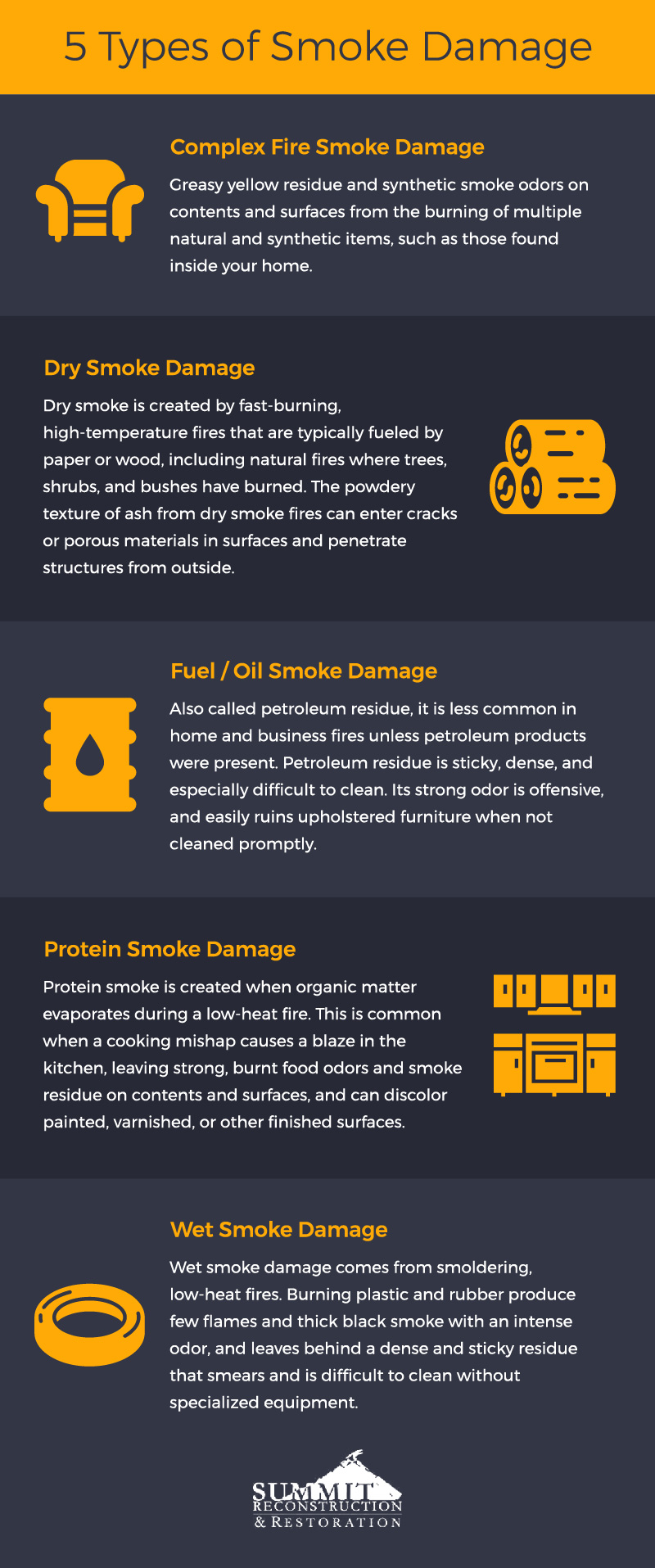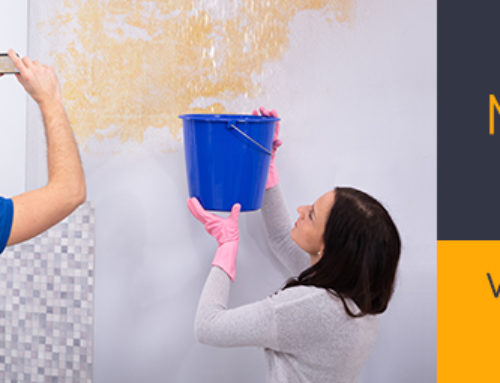Where does the smoke damage restoration process begin and where does it end? It’s not as simple as just repainting or cleaning out burned items. Smoke damage poses multiple health risks that requires proper restoration to address. Proper smoke damage restoration requires training, experience, and certification to properly complete and remove those health risks.
What is smoke damage?
The damage left behind after a fire can be significant, but damages are not only structural. Smoke damage can be a significant concern after a fire, and proper smoke restoration is important to mitigate health hazards.
Any part of a structure and its contents are susceptible to damage, even if they weren’t directly affected by a fire itself. Smoke and ash can not only cause significant damage to the surrounding area of where a fire happened, they can continue to cause corrosion to materials if not addressed.
- In a matter of hours, walls, kitchen appliance finishes, and other surfaces can become discolored.
- Smoke will quickly tarnish metal and cause etching in glass.
- Odors and discoloration from smoke will stay in a room or a home long after the fire, indicating that there are probably toxins left behind, and should be removed to prevent health issues.
There are typically five types of smoke damage common in restoration projects. Each is caused by different circumstances, like the fire’s temperature, fueling materials, and location. The restoration process varies slightly for each.
Complex Fire Smoke Damage
Greasy yellow residue and synthetic smoke odors on contents and surfaces from the burning of multiple natural and synthetic items, such as those found inside your home. Emergency corrosion mitigation is necessary to protect at-risk surfaces.
Dry Smoke Damage
Dry smoke is created by fast-burning, high-temperature fires that are typically fueled by paper or wood, including natural fires where trees, shrubs, and bushes have burned. The dry smoke from natural fires can enter cracks or porous materials in surfaces and penetrate structures from outside, so smoke residue and odor are present.
The powdery texture of ash from dry smoke fires means it doesn’t smear wiped, which makes it relatively easy to clean compared to more dense smoke and soot residue. This means that it’s possible for the surfaces of your space to appear clean even while a smoky odor persists. Dry smoke doesn’t smell as strongly as the other types of residues, and it’s not difficult for a professional company to eliminate the odor.
Fuel/Oil Smoke Damage
Also called petroleum residue, is less common in home and business fires unless petroleum products were present. However, heating appliances like oil-fired furnaces can malfunction. If it doesn’t ignite properly smoke and soot can be distributed throughout the property and surrounding space in the form of a small leak or minor explosion.
Petroleum residue is sticky, dense, and especially difficult to clean. Its strong odor is offensive, and easily ruins upholstered furniture when not cleaned promptly.
Protein Smoke Damage
Protein smoke is created when organic matter evaporates during a low-heat fire. This is common when a cooking mishap causes a blaze in the kitchen, leaving strong, burnt food odors can permeate an entire home, and smoke residue on contents and surfaces can discolor painted, varnished, or other finished surfaces.
Wet Smoke Damage
Wet smoke damage comes from smoldering, low-heat fires. Burning plastic and rubber produce few flames and thick black smoke with an intense odor, and leaves behind a dense and sticky residue that smears and is difficult to clean without specialized equipment.
What is the goal of smoke damage restoration?
The goal of smoke restoration is to remove any evidence that there was ever smoke in the first place. Smoke restorers work to ensure that a home or building is returned to the state in which it was before the damage occurred.
Smoke Damage Risks
Proper smoke restoration means removing and preventing the chemical and structural hazards that pose serious health risks that can occur after a fire.
Smoke Related Health Risks
The chemicals left behind after a fire as a result of damaged and contaminated building materials can continue to pose significant health risks to inhabitants if a property is improperly restored after a fire.
Breathing and other respiratory complications like bronchitis or asthma can occur, in addition to skin and eye irritation, redness, dryness, and itching.
If proper restoration is not completed after a fire, there can be long-term health risks, including cancer, stroke, heart attacks, and lifelong consequences for infants.
Building Materials that Pose Health Risks After a Fire
In addition to unsightly damage and unpleasant odors, fire and smoke leave behind residues that can pose serious health risks. Building materials can release toxic chemicals when burned, and those chemicals can contaminate surrounding materials. It’s important to make sure any of the below damaged and affected materials are cleaned or removed:
- Plastics
- Carpets
- Upholstery
- Wood products
- Insulation
- Wool
- Foams
- All materials containing asbestos
If there is any trace of odor or discoloration after attempts at cleaning these materials, they must be properly disposed of and replaced.
Toxic Chemicals After a Fire
After a fire, odors and discoloration can indicate that the environment has likely been contaminated with hazardous chemicals that were released during the fire. These chemicals pose significant health risks. Products that can release toxins when burned are common building materials and household items.
PVC (Polyvinyl chloride)
PVC is the world’s third-most widely produced synthetic plastic polymer— over 40 million tons are produced each year. It’s used in flooring, plumbing, roofing, siding, protective clothing, and more. When burned, PVC releases a number of chemicals, all of which can be harmful to humans, including:
- Hydrogen chloride
- dioxin chloromethane
- Halocarbons
- Phosgene
- Bromomethane
Carbon Materials
Since carbon building materials are readily available and used in abundance, they can pose a serious health risk after a fire if not properly restored or removed. When burned, these materials can release:
- Ammonia
- Nitrogen oxide
- Tar
- Hydrogen
- Carbon monoxide
What to Expect in Smoke Damage Restoration
A house, business, or forest fire can be devastating as is, but some people may not know that the clean up process of the ash, soot, and chemicals left behind can be dangerous, and is best left to the restoration professionals.
Anything that was affected by the smoke or fire is repaired, cleaned, or replaced, with the objective of removing any toxins, odors, and discoloration.
Remove Smoke Damaged Belongings
In the event of a large fire where significant damage took place, demolition is performed if necessary, as well as the removal of unsalvageable materials, including wood, insulation, flooring, drywall, and roofing.
Any damaged belongings will need to be cleaned and restored or discarded, including, but not limited to furniture, clothing, appliances, electronics, and books.
When clear out is taking place, home contents are evaluated for recovery based on a number of factors:
- Replacement cost vs. restoration cost
- Effect of smoke and heat
- Loss of use
- Loss of value
- Decreased obsolescence expectancy
- Sentimental value
Smoke Cleaning & Remediation
Anything that was touched by fire or smoke should be cleaned or disposed of to remove fire-related compounds.
Smoke cleaning and remediation tasks include:
- Ash, smoke, and soot removal
- Smoke odor cleaning
- Air purification
- Ventilation
- HEPA Vacuuming
- Dry-cleaning with chemical sponges
- Ozone treatment
- Thermal fogging
- Application of sealers
All belongings should be cleaned, repaired, or removed. Surfaces that require cleaning after a fire include, walls, ceilings, flooring, light fixtures, windows, shelving, counters, and doors.
Water Remediation
Many times, in addition to smoke damage, a fire will result in water damage, so water extraction and remediation is required.
This can involve removing water with truck-mounted or portable extractors, wet/dry vacuums, or submersible pumps, depending on the severity.
Drying and dehumidifying with industrial quality air movers and dehumidifiers are used to dry out any materials that still contain excess moisture or are too challenging to access during extraction.
Repairing & Rebuilding Fire & Smoke Damage
After smoke cleaning and remediation has taken place, any building materials that are beyond remediation will be removed and replaced, such as:
- Drywall
- Insulation
- Flooring
- Tiles
- Plumbing fixtures
- Light fixtures
- Windows
- Doors
- Shelving
- Counters
- Ventilation
- Roofing
Proper restoration and rebuilding is important to reduce the likelihood of construction defects.
If damage to a wall or support beam is not repaired, even greater structural damage can occur. If plumbing, roofing, exterior walls, windows, or siding are not properly fixed, it can cause a leak and then you have to deal with water damage. And if that weren’t bad enough, potential mold damage on top of that. If electrical wiring is not repaired right, there could be another fire.
At Summit Reconstruction & Restoration, we have years of training and experience in the restoration and repair of fire and smoke damage, water damage, and construction defects. We evaluate each building holistically to take the extra steps necessary to identify and resolve underlying issues with all critical building systems, ensure that the mitigation process is comprehensive and thorough, and the restoration and repair process include thoughtful selection of materials and installation processes in order to reduce or eliminate the risk of recurrence.
The most common repairs in fire restoration are mechanical, structural, and cosmetic:
- Repairing framing and other structural components
- Repairing electrical systems, plumbing, gas pipes, or HVAC
- Replacing insulation, doors, windows, decks, and glass panes
- Re-roofing, re-siding, and trim and siding repair
- Rebuilding stairways and boundary walls
- Replacing flooring, tiles, carpeting, light fixtures, drywall, and plaster
- Redecoration such as whitewashing, painting, or refinishing
- Rebuilding or repairing non-structural walls, smoke chimneys, cabinets and other carpentry.
Go to the Professionals for Smoke Remediation & Fire Restoration
Summit Reconstruction & Restoration is not only the best reconstruction crew in Portland Metro, we’re your one-stop contractors for smoke and fire remediation, restoration, and reconstruction. If you are a property owner who has recently suffered from damage of any kind, we want to help you restore your property to its former glory. Get in touch with us for restoration, rebuilding, or special and unique projects.








